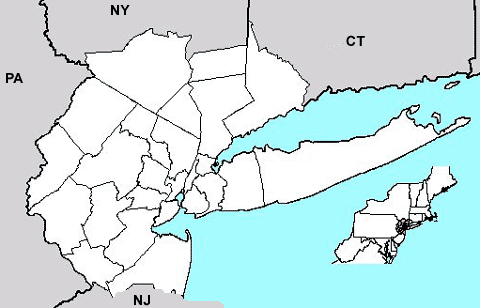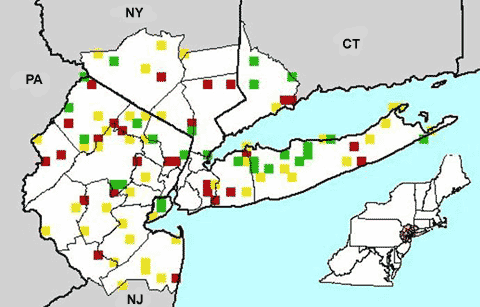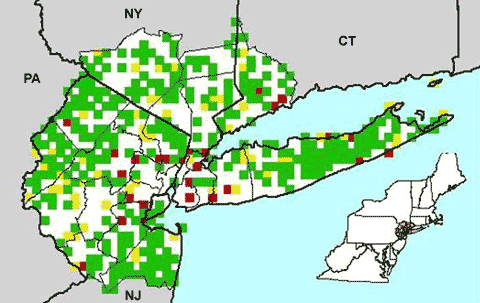An Overview of the New York Metropolitan Flora Project
by Gerry Moore, Angela Steward, Steven Clemants, Steven Glenn, and Jinshuang Ma
Brooklyn Botanic Garden, 1000 Washington Avenue, Brooklyn, NY 11225
Published online October 23, 2002
Abstract
This paper provides an overview of Brooklyn Botanic Garden's New York Metropolitan Flora (NYMF) project. Previous efforts to document the flora of the New York metropolitan region are reviewed, including the contributions of many notable botanists (e.g., Arthur Cronquist, Merritt Fernald, Asa Gray, and John Torrey), institutions (e.g., Harvard University and The New York Botanical Garden), and groups (e.g., Torrey Botanical Society and Philadelphia Botanical Club). The methodologies used for the NYMF project are discussed, such as the area covered by the flora project, how data are collected, and how data are stored and analyzed. Some results of the NYMF project are considered, highlighting the two major trends that are found in the flora: the decline of native species and the spread of nonnative plants. The paper also covers how the results of the NYMF project are being made available to the public not only through publications but also by the NYMF Web site maintained by Brooklyn Botanic Garden.
Introduction: A Review of Floristic Research in the Region
The flora of New York City and its environs has been studied in one form or another for the past 250 years. Cadwallader Colden published one of the first accounts (if not the first account) of the region's plants with his Plantae Coldenhamiae (1743, 1751). Other early botanical explorers of the region included John Bartram, William Bartram (son of John Bartram), Jane Colden (daughter of Cadwallader Colden), and Peter Kalm.
By the mid-18th century, much of the New York metropolitan area's flora had been documented. Of the roughly 3,000 species (including native and nonnative species) that now occur here, approximately 50% were accounted for in Linnaeus's 1753 compendium of the world's plants, Species Plantarum (1753).
Following a century of basic exploration, botanists began to assemble the data into floras (in this case, floras of the northeastern United States). Among the earliest of these were A. Michaux's Flora Boreali-Americana (1803), C.H. Persoon's Synopsis Plantarum (1805-1807), F. Pursh's Flora Americae Septentrionalis (1814), and T. Nuttall's Genera of North American Plants (1818). The tradition of publishing regional floras has continued to the present.
A center of regional floristic study developed in New York under John Torrey. In 1824, Torrey published Flora of the Northern and Middle Sections of the United States. This was followed roughly 75 years later by Nathaniel Lord Britton and Addison Brown's An Illustrated Flora of the Northern United States (1896, 1897) and the Manual of the Flora of the Northern States and Canada (1901). The most recent floristic treatments are Henry Allan Gleason and Arthur Cronquist's Manual of Vascular Plants of Northeastern United States and Adjacent Canada (1991) and Noel H. Holmgren's The Illustrated Companion to Gleason and Cronquist's Manual (1998), the standard texts for plant identification in the region today.
Asa Gray, a student of John Torrey's, founded a second center of northeastern U.S. floristics at Harvard University. In 1848, he published A Manual of Botany of the Northern United States (1848). The eighth edition of his book, now known as Gray's Manual of Botany (Fernald, 1950), is still frequently used for the identification of plants in the northeastern United States.
In addition to regional floras, numerous studies of the flora in the immediate area around New York City have been steadily produced. John Torrey published the first catalog of these plants in 1819. This was one of the earliest local floras in the country, preceded only by Jacob Bigelow's Florula Bostoniensis (1814) and William Barton's Compendium Florae Philadelphicae (1818). It has been followed periodically by other floras, catalogs, and checklists of the metropolitan region (see Table 1).
Torrey was also influential in developing amateur botanical expertise in New York City. He and his colleagues founded the Torrey Botanical Club (now the Torrey Botanical Society) in 1867. Botanical clubs were founded in other cities in the Northeast as well, most notably the Philadelphia Botanical Club (1891) and the New England Botanical Club (1895).
These clubs played, and continue to play, a very important role in the understanding of local flora. Each publishes a scholarly journal (the Journal of the Torrey Botanical Society, Bartonia, and Rhodora, respectively). Each has amassed and cared for extensive herbaria (the Torrey Botanical Society herbarium is now incorporated into The New York Botanical Garden; collections made by Philadelphia Botanical Club members are incorporated into the Academy of Natural Sciences, in Philadelphia; the New England Botanical Club herbarium is housed within the Harvard University Herbaria collections). And each has organized local field trips every year for the past century.
These clubs and their activities have been vital to our current study and will continue to be important components of any future studies. New botanical clubs, such as the Connecticut Botanical Club and the Long Island Botanical Society, are extending and deepening this heritage.
Project Background
In 1989, Brooklyn Botanic Garden recognized the importance of local flora studies by hiring Steven Clemants as its director of Science (he is now the institution's vice president of Science). The following year, Clemants founded the New York Metropolitan Flora project (NYMF). The project's purpose is to document all vascular plants that grow without cultivation in the metropolitan area. The NYMF range extends to all counties within roughly a 50-mile radius of New York City, and it includes all of Long Island, all of northern New Jersey (south to Mercer and Monmouth Counties), part of southeastern New York (Orange, Putnam, Rockland Counties), and Fairfield County, Connecticut. The region covers approximately 7,650 square miles and includes a total of 25 counties (see Figure 1).
In addition to the authors of this paper, several other scientists have contributed to NYMF research. They include Kerry Barringer (current curator of Brooklyn Botanic Garden Herbarium), Bryan Dutton (a former research taxonomist at Brooklyn Botanic Garden, currently on the faculty at Western Oregon University), and Katherine Gould (another former research taxonomist at Brooklyn Botanic Garden, currently on the faculty at Austin Peay State University). Many volunteers, especially members of the local botanical clubs and societies, have also contributed to the project.
For collecting and surveying purposes, the project uses a grid system based on the New York Transverse Mercator Grid (a variation of the Universal Transverse Mercator Grid). The same grid used in the Atlas of Breeding Birds of New York State (Andrle & Carroll, 1988), it breaks down the metropolitan region into 964 five-by-five-kilometer cells or blocks (Figure 2). As far as possible, every record in the NYMF database corresponds to one of these blocks.
On a typical NYMF map, record(s) of the same species in one block appear as a dot (see Figures 3 and 4 for examples). The most current records supersede older ones.
Data entered into the database are derived from three main sources: 1) collections made in the field; 2) observations made in the field; 3) published data. To date, the NYMF database consists of more than 200,000 records taken from these three sources.
Collections are constantly being made in the field by all NYMF staff. Sixty blocks were randomly selected to serve as voucher blocks. In these voucher blocks, collections are made of all species encountered. These specimens are deposited in the herbarium of Brooklyn Botanic Garden. Furthermore, all herbaria that have significant collections in the NYMF range have been inventoried. These herbaria include the Academy of Natural Sciences, Philadelphia (PH) (abbreviations follow Holmgren, Holmgren & Barnett, 1990); Brooklyn Botanic Garden (BKL); Cornell University (BH, CU); Harvard University (A, GH, NEBC); The New York Botanical Garden (NY); New York State Museum (NYS); Rutgers University (CHRB); Smithsonian Institution's National Museum of Natural History (US); Staten Island Institute of Arts and Sciences (SIM); University of Connecticut (CONN); and Yale University (Y). The field-collection data of the NYMF staff are significant because most records from herbaria were obtained before 1990.
In addition to compiling vouchered data, the NYMF staff makes nonvouchered observations in the field, and these records are also entered into the database. Observations made by others are also entered (for example, the records of Stanley Smith, the first curator of the herbarium of the New York State Museum, are included). Since some questions regarding species identity cannot be answered without a voucher specimen, this approach could be criticized. However, a parallel may be drawn in the common use of observational data in bird studies. Furthermore, the presence of a detailed vouchered database for comparison lessens the risk of error in using nonvouchered data. Moreover, it is the only practical way to get a reasonably complete picture of distributions. The NYMF range is large, and it is not feasible to have collections for all species in each block. Because each block unit is small, most questions regarding records can be answered by physically visiting a particular block.
Published records of plants are also entered into the NYMF database. Most of these are from floristic articles or field-trip reports that have appeared in Bartonia, Bulletin (Journal) of the Torrey Botanical Club (Society), and Torreya.
Publishing Results
The NYMF project is divided into six distinct research segments: 1) woody plants; 2) aquatic and wetland plants; 3) grasses, sedges, and rushes; 4) ferns; 5) wildflowers; and 6) weeds. So far, fieldwork for the woody-plant phase has been completed, and a volume on the woody plants of the metropolitan region is in preparation. Our current fieldwork is focused on aquatic and wetland plants.
In addition to printing volumes on the research segments of the project, we are also publishing our results online at http://www.bbg.org/sci/nymf/ as they are produced. On the NYMF Web page, technical and nontechnical information is provided for each species. The technical information consists of nomenclature (accepted name and synonyms), description, habitat, distribution, rarity status, species biology, and references. The nontechnical information consists of common name, field-identification data, food uses, and relevant Brooklyn Botanic Garden student projects.
Identification keys are also provided. Currently these consist of keys to genera and general keys to the woody plants. Interactive keys will soon be available on the Web site.
Conclusion: A Dynamic Tool
Several components of the NYMF project make it different from previous floristic studies of the area. NYMF does not focus on some areas more than others but rather attempts to survey the entire region uniformly. Sampling occurs in all the five-by-five-kilometer blocks, and this buffers against sampling bias in the floristic accounts. The small block unit also permits the creation of highly detailed range maps (as opposed to county-sized range maps). Our database also allows its users to "mine" it to develop such lists as the most widespread woody plants in the area (Table 2) and arrival dates of common woody invasive plant species (Table 3).
The NYMF project is unique because it documents all vascular plants that occur without cultivation in the region. It focuses on nonnative plants as well as native ones, common species as well as rare or endangered ones. Our approach differs from that of earlier floristic studies in which nonnative species were often ignored or only casually mentioned. An example of this kind of study is W. Stone's flora of southern New Jersey (1912). In it, the author writes, "Important as is the study of weeds from an economic standpoint, they have little or no significance in a geographic discussion of plant life, their principal function being to aid in obliterating all trace of the original range of the native vegetation."
Besides destruction of habitat, the greatest threat to native plants in the metropolitan region is the introduction and spread of nonnative plants. Our staff has documented the occurrence and spread of numerous nonnative plant species. For example, A. Steward, S.E. Clemants, and G. Moore have documented how the aggressive nonnative Oriental bittersweet (Celastrus orbiculatus) has rapidly spread and become a common weed in the NYMF range, while the native American bittersweet (C. scandens) has become increasingly scarce. It is hypothesized that the spread of C. orbiculatus is contributing to the decline of C. scandens (Steward, Clemants & Moore, in press).
NYMF is also documenting the occurrence of rare plants in the region and noting the decline of species that were at one time more abundant. For example, S.D. Glenn (2001) recently rediscovered Rhododendron (Ledum) groenlandicum in New Jersey. Prior to Glenn's discovery, the species had not been seen there since 1977 (Hough, 1983; Glenn, 2001). It also appears that Chimaphila umbellata, which once occurred frequently in the New York metropolitan range, has declined considerably (Figure 3). Meanwhile, the closely related species C. maculata, which grows in similar habitats, appears to have remained stable (Figure 4).
The NYMF flora is being compared with other urban floras (Clemants, 2002) to discover possible large-scale floristic trends. Future research may focus on changes in plant ranges and blooming times that might be the result of global warming or other major climatological changes. An example of a plant whose range has changed recently is the composite Heterotheca subaxillaris, which was not known north of Delaware in the early 1900s; today it is common in the NYMF region.
The publication of floristic treatments of the region in the 20th century in no way precludes the need for floristic research programs in the 21st century. Indeed, when the NYMF project is finally completed and treatments have been written for all the species that occur in the region, it will be time to start over again.




